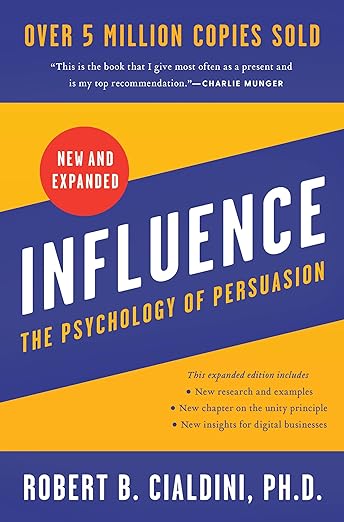“Influence: The Psychology of Persuasion” by Dr. Robert Cialdini
Who is it for? for those interested in the dynamics of persuasion
Dr. Robert Cialdini’s “Influence: The Psychology of Persuasion” is a seminal work in the field of psychology and marketing, offering deep insights into the art and science of persuasion. Drawing upon his extensive research and experiments, Cialdini presents six key principles of influence: reciprocity, commitment and consistency, social proof, authority, liking, and scarcity. These principles explain how people are persuaded and how one can become more persuasive in personal and professional interactions.
Cialdini’s book is not just an academic treatise but a practical guide, filled with real-world examples that make the concepts accessible and relatable. Each principle is thoroughly explored with evidence and anecdotes, illustrating how these tactics are used in various settings, from sales and advertising to everyday decision-making.
The main challenge for readers of “Influence: The Psychology of Persuasion” is applying these principles ethically and effectively in their own lives. While the book provides a blueprint for understanding and employing the mechanics of persuasion, there is a fine line between ethical persuasion and manipulation. Readers must be cautious to use these principles responsibly, ensuring they do not exploit or deceive others.
Another challenge lies in integrating these principles into one’s communication style without being overt or artificial. Successfully applying Cialdini’s principles requires subtlety, a deep understanding of human psychology, and the ability to adapt one’s approach to different situations and individuals.
Furthermore, for some readers, the book might present a somewhat cynical view of human behaviour, as it lays bare the techniques of manipulation used in various industries. This revelation requires a critical examination of both how one is influenced by others and how one influences others.
In conclusion, “Influence: The Psychology of Persuasion” is a profoundly insightful and useful book for anyone interested in the dynamics of persuasion. The challenge lies in applying these principles judiciously and ethically, balancing the power of influence with respect for the autonomy and well-being of others. For those interested in the psychological underpinnings of influence, Cialdini’s book is an invaluable resource.

